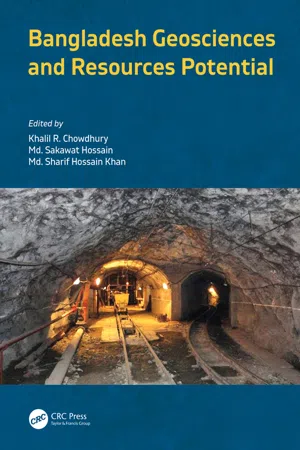
Bangladesh Geosciences and Resources Potential
- 610 pages
- English
- ePUB (mobile friendly)
- Available on iOS & Android
Bangladesh Geosciences and Resources Potential
About This Book
This book focuses on the potential natural resources of Bangladesh from Precambrian to recent times and their detailed geological background. Natural resources and their management are important for the sustainable economic development of a country. Focusing on the geological setting of the Bengal Basin, Bangladesh Geosciences and Resources Potential introduces and comprehensively describes the depositional environments, status and prospects of the potential natural resources of Bangladesh. Individual chapters outline the potential resources comprising a wide range of deposit types across the country. A selective overview of these natural resources—metallic minerals, coal, limestone, hydrocarbon, peat, placer deposits, surface, groundwater and so forth—is provided with relevant references. The book gives a synthesis of the issues in the mineral, hydrocarbon and water resource sectors from a resource-economic perspective.
FEATURES
-
- Provides a geoscientific knowledge of the potential natural resources with relevant maps, figures and tables pertaining to the Bangladesh region
-
- Explains the resource-economic context, geomorphology and sustainable land use and the effects of climate change on both surface water and groundwater resources
-
- Discusses resource potentials based on systematic geological stages
-
- Presents the resources of renewable energy and discusses how to increase their use and effectiveness
-
- Reinforces basic geological processes and outcomes with an understanding of resource geology and constraints on natural resource management
This book is aimed at researchers, graduate students and professionals in geology, energy and mineral resources, hydrogeology, water resources engineering, the environmental sciences and resource exploration and planning.
Frequently asked questions
Information
1Introduction to Bangladesh Geosciences and Resources Potential
- 1.1Bangladesh and the Bengal Basin
- 1.2Tectonic Setting, Geological Provinces, and Stratigraphy
- 1.2.1Geotectonic Province 1: Western Flank of the Bengal Basin
- 1.2.2Geotectonic Province 2: The Foredeep Basin
- 1.2.3Geotectonic Province 3: The Folded Flank
- 1.2.4The Bay of Bengal
- 1.3Geological and Tectonic Maps
- 1.4The Exploration History of Natural Resources
- 1.4.1Hydrocarbon
- 1.4.2Limestone
- 1.4.3Coal
- 1.4.4Peat
- 1.4.5Beach Sand
- 1.4.6Water
- 1.4.7The Blue Economy
- 1.4.8Renewable Energy
- 1.5Unconventional Energy Resources
- 1.6Overview of the Book
- 1.7Scope of the Book
- References
1.1 Bangladesh and the Bengal Basin

1.2 Tectonic Setting, Geological Provinces, and Stratigraphy
1.2.1 GEOTECTONIC PROVINCE 1: WESTERN FLANK OF THE BENGAL BASIN
- The Himalayan Foredeep: This tectonic unit is marked by high negative Bouguer gravity anomaly ranging from -110 mGal in the south to -150 mGal in the north, which suggests noticeable thickening of basinal strata northward into the Siwalik foreland basin of the northeastern Himalaya (Rabbani et al., 2000; Uddin and Lundberg, 2004). In this unit, the Neogene clastic sediments attain a thickness of 3–4.5 km (Rabbani et al., 2000). At its northern edge, clear evidence of an active deformation zone has been found, as indicated by active faulting, uplift and surface rupture, and frequent seismicity (Hossain et al., 2020b).
- The Dinajpur Shelf: This is also known as the Dinajpur Slope or Northern Foreland Shelf of the Bengal Basin, and is characterised by an almost E-W trending linear Bougue...
Table of contents
- Cover
- Half-Title Page
- Title Page
- Copyright Page
- Dedication
- Table of Contents
- Abbreviations
- Foreword
- Preface
- Editors
- List of Contributors
- 1 Introduction to Bangladesh Geosciences and Resources Potential
- 2 Precambrian Basement Rock of Bangladesh and Its Metallic Minerals
- 3 Gondwana Deposits of the Bengal Basin (Bangladesh) and Coal Potential
- 4 Limestone Deposits of Bangladesh and Their Potential
- 5 Petroleum System of Bangladesh and Its Hydrocarbon Reserves and Resources
- 6 Hydrocarbon Resource Potentials of Bangladesh
- 7 Peat Resources in Bangladesh and Challenges for Their Development
- 8 Placer Deposits of Bangladesh and Their Potential Commercialisation
- 9 Resource Potentials of the Marine Areas of Bangladesh
- 10 Geomorphology of Bangladesh and Potential Land Use
- 11 Groundwater Resources, Challenges and Governance in the Bengal Basin, Bangladesh
- 12 River-Borne Sediments of Bangladesh and Their Economic Importance
- 13 The Surface Water System, Flood and Water Resources Management of Bangladesh
- 14 Global Climate Change and Its Effects on the Water Resources of Bangladesh
- 15 Renewable Energy and Its Prospects in Bangladesh
- Index